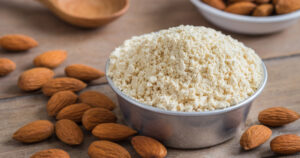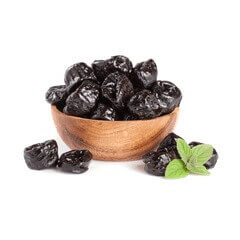Why Almonds are Necessary for Us?
The almond is a kind of tree nut that is native to the Mediterranean region. Almond trees flourished wild there in the past and were later cultivated as early as 3000 BC. Almonds are even mentioned as a valued meal given as a gift in the first book of the Bible, Genesis. The edible component of an almond is a seed from a drupe, a fruit in which the outer shell and hull layers are normally not consumed. After the almond seed has been extracted, the shells and hulls are frequently utilised as livestock feed and bedding. One ounce of almonds represents around 23 almonds or ¼ cups. It is a calorie-dense meal that is also nutrient-dense, with the bulk of its fat being monounsaturated. One ounce contains approximately 165 calories, 6 grams of protein, 14 grams of fat (80% monounsaturated, 15% polyunsaturated, and 5% saturated), 6 grams of carbohydrate, and 3 grams fibre.
Almonds and Health
Almonds have been linked to a decreased risk of heart disease through reducing total and LDL cholesterol and exerting anti-inflammatory and antioxidant effects. Plant sterols, such as those contained in almonds, may interfere with cholesterol and bile acid absorption, and the significant quantity of unsaturated fat in almonds promotes a better lipid profile, especially when this diet replaces other foods rich in saturated fat and refined carbohydrates. Almonds are also rich in phytonutrients, which promote the growth of beneficial gut microbes. Controlled research has demonstrated that consuming nuts in general helps to reduce inflammation, support healthy blood vessels, and reduce insulin resistance. Interestingly, despite the fact that nuts are high in calories, research does not indicate a connection between nut consumption and weight gain. In fact, they’ve been linked to reduced weight gain and a lower risk of obesity, because the fat and fibre content improves feelings of fullness and satisfaction. There is limited research on almond consumption in large populations. Smaller controlled trials have focused on almonds, while larger observational studies have focused on nuts in general, owing to the population’s limited intake of particular nuts. Observational research on nut consumption indicated that people who ate nuts at least four times per week had a considerably decreased risk of heart disease.

Small randomised controlled studies have revealed consistent effects of nut-enriched diets, notably almonds reduce total and LDL cholesterol in the blood. A major epidemiological research of health professionals revealed that eating tree nuts, especially almonds, twice a week was related to a 13% reduced risk of overall cardiovascular disease and a 15% lower risk of coronary heart disease. Another large prospective research of Swedish people indicated that those who ate nuts 1-2 times per week had a 12% lower risk of atrial fibrillation, and an 18% lower risk if consumed 3 or more times per week, as compared to individuals who ate no nuts. Those who ate nuts 1-2 times per week had a 20% lower risk of heart failure when compared to non-nut eaters. According to meta-analyses, a higher nut intake is related to a lower risk of total cardiovascular disease, total cancer, and all-cause mortality. These studies found inconsistent evidence of a protective benefit of nut consumption against diabetes, respiratory disease, stroke, and infections. Because previous scientific evidence suggested that eating nuts may reduce the risk of heart disease, the U.S. Food and Drug Administration approved manufacturers in 2003 to indicate on food labels that eating 1.5 ounces of most nuts per day as part of a diet low in saturated fat and cholesterol may reduce the risk of heart disease.
Purchase
Raw, blanched, dry-roasted, and oil-roasted almonds are all available. They are available whole, sliced, chopped, or slivered. Though they are most commonly found plain or salted, they are also available in honey-roasted, BBQ, chili, chocolate-covered, and other flavors, all of which can add calories, sodium, and sugar to the diet. Raw almonds are nutritionally equivalent to dry-roasted almonds. Almonds should be stored in cold, dark, and dry places. Almonds may be stored for around two years if maintained at temperatures below 40°F.
Almond Milk
This dairy-free plant milk has no cholesterol or lactose, making it appealing to people on a low-cholesterol diet or who are lactose intolerant. It is made by finely grinding almonds with water and then straining the almond pulp. The remaining liquid can then be supplemented with minerals such as calcium and vitamins A and D. While unsweetened almond milk is the best option, many include additional sugars, so read the nutrition label carefully.

Almond Butter
Almond butter has a similar consistency to peanut butter but can be used as an alternative for individuals who are allergic to peanuts. Jarred almond butter is often more costly than peanut butter, with prices ranging from $5 to $15. Make your own almond butter for a less expensive option. In a food processor or high-powered blender, grind 1 pound of dry-roasted almonds, starting on low and gradually raising the speed. Pause the processor to scrape the sides and break up any large pieces. It may take a few minutes for the consistency to change to paste. As the oils are released, the longer you mix, the smoother the paste will become. For a variety of tastes, use cinnamon, nutmeg, vanilla essence, or curry. You can store it in the refrigerator for up to 2-3 weeks.
Almond Flour or Almond Meal
This gluten-free and low-carb flour substitute is made of finely ground almonds. To get a finer texture, the almonds are blanched and the skins removed. It has more nutrients than wheat flour, but it also contains more calories and fat. Because almond flour has more moisture than all-purpose flour, a larger quantity is frequently required when substituting it for other flour in recipes. In general, 34 cups of all-purpose flour equal around 12 cups of almond flour. Keep in mind that the extra moisture in almond flour may cause baked items to spoil or mold, so store them in an airtight container. Almond flour may be kept in the refrigerator in a sealed container for up to 6-9 months; freezing may prolong the shelf life even more.

Usage of Almonds
Unsalted almonds, chopped or slivered, may be found in the baking aisle and make an excellent topping for hot and cold cereals, salads, and baked goods. Almond butter may be spread on sliced apples or whole-grain bread. To make a richer-tasting oatmeal, toss in a spoonful of almond butter as soon as the oats are cooked. Replace less healthful snacks like chips and pretzels with crisp and nutritious almonds. In baked items or as a breading for fish, use almond flour instead of all-purpose flour.
Did You Know?
California is the world’s largest almond producer, producing approximately 80% of worldwide production. Honeybees and wild bees are totally dependent on almond trees to pollinate their blossoms and produce the almond drupe. Almond milk and almond butter have shown an increase in customer demand among all almond products. Between 2011 and 2015, almond milk sales increased by 250%, and almond butter production tripled.
Where to Buy?
The best place to buy quality almonds is www.adnoor.ca feel free to visit our website.







